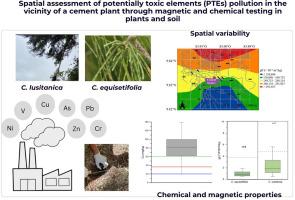Spatial assessment of potentially toxic elements (PTEs) pollution in the vicinity of a cement plant through magnetic and chemical testing in plants and soil
Q2 Environmental Science
引用次数: 0
Abstract
Cement plants are a potential source of environmental pollutants, particularly potentially toxic elements (PTEs). Some PTEs are trapped in clinker, while others volatilize, adhering to dust particles and contributing to atmospheric pollution. These PTEs persist in the environment, bioaccumulate, and are toxic, posing risks to ecosystems, agriculture, and health. This study employs both magnetic and chemical methods to evaluate soil and plant contamination in the vicinity of a cement plant. Soil magnetic susceptibility (χlf) was twice the background level at 80% of sites, indicating significant anthropogenic enrichment. While plants (C. equisetifolia and C. lusitanica) showed lower χlf values than the soil, and notably more superparamagnetic (SP) material, this suggests airborne particulate contamination. Elevated Cu, Cr, and As levels were found in soils, with Cr, Ni, V, Pb, and Zn elevated in plants. Nevertheless, considering the spatial distribution, year-round wind direction, and the long-term accumulation of these metals in soil, their enrichment by PTEs is likely more influenced by urban activities such as traffic and agriculture rather than the cement plant. Correlations between χlf and metals like Cu, Ni, As, Zn, and Cd suggest magnetic measurements are reliable pollution indicators.

通过对植物和土壤的磁性和化学测试对水泥厂附近潜在有毒元素(pte)污染进行空间评估
水泥厂是环境污染物的潜在来源,特别是潜在有毒元素(pte)。一些pte被困在熟料中,而另一些则挥发,附着在尘埃颗粒上,造成大气污染。这些pte在环境中持续存在、生物积累并具有毒性,对生态系统、农业和健康构成风险。本研究采用磁性和化学方法来评估水泥厂附近的土壤和植物污染。80%的地点土壤磁化率(χ f)是背景水平的两倍,表明明显的人为富集。而植物(C. equisetifolia和C. lusitanica)的χ f值低于土壤,并且超顺磁性(SP)物质明显更多,这表明空气中的颗粒物污染。土壤中的Cu、Cr和As含量升高,植物中的Cr、Ni、V、Pb和Zn含量升高。然而,考虑到这些金属在土壤中的空间分布、全年风向和长期积累,pte的富集可能更多地受到交通和农业等城市活动的影响,而不是水泥厂。χ f与Cu、Ni、As、Zn和Cd等金属的相关性表明,磁测量是可靠的污染指标。
本文章由计算机程序翻译,如有差异,请以英文原文为准。
求助全文
约1分钟内获得全文
求助全文
来源期刊

Environmental Challenges
Environmental Science-Environmental Engineering
CiteScore
8.00
自引率
0.00%
发文量
249
审稿时长
8 weeks
 求助内容:
求助内容: 应助结果提醒方式:
应助结果提醒方式:


